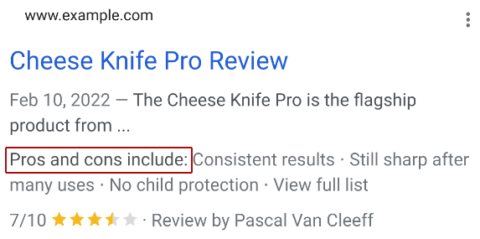Google updated its structured data documentation for Editorial Product Review webpages. There is now a new Pros and Cons structured data that makes sites eligible for an enhancement in search.
This change to Google’s structured data for product reviews can significantly impact product review websites.
Only editorial product review sites can have an enhanced listing in the search results when they use these new structured data properties.
Merchants are not eligible for the pros and cons enhancement in Search, nor are customer product review pages.
That means this update to the structured data affects product review websites, including product review affiliate sites, that do not sell the products themselves but are focused on reviewing the products.
What Is Pros & Cons Structured Data?
The pros and cons structured data is used by Google to identify specific information in product reviews and display it in the search results.
The structured data Google uses for pros and cons is based on the positiveNotes and negativeNotes Schema.org structured data properties.
What’s interesting about these structured data properties is that they are not yet fully integrated into Schema.org.
According to the official Schema.org page for these kinds of structured data:
“This term is proposed for full integration into Schema.org, pending implementation feedback and adoption from applications and websites.”
Eligible Languages for Product Review Pros & Cons
Websites in the following ten languages are eligible to be shown with the new enhancement in search:
- Dutch
- English
- French
- German
- Italian
- Japanese
- Polish
- Portuguese
- Spanish
- Turkish
Guidelines
Google has published new guidelines that in addition to limiting the eligibility for a pro/con enhancement in Search also states that at least two pro or con statements must be made.
That means it can consist of a minimum of two pros, two cons or one of each (a pro and a con).
According to the new documentation:
“Currently, only editorial product review pages are eligible for the pros and cons appearance in Search, not merchant product pages or customer product reviews.
There must be at least two statements about the product. It can be any combination of positive and/or negative statements (for example, ItemList markup with two positive statements is valid).
The pros and cons must be visible to users on the page.”
Pros & Cons Structured Data is Prioritized
Google noted that editorial review webpages that don’t use the new structured data can still be eligible for an enhancement in search if Google can figure it out from the text on the webpage.
However, Google will give priority to editorial review pages with structured data.
The announcement stated:
“If you do not provide structured data, Google may try to automatically identify pros and cons listed on the web page.
Google will prioritize supplied structured data provided by you over automatically extracted data.”
Is it Hard to Add New Structured Data?
If you’re using a plugin, whoever maintains it should be adding the new structured data.
It shouldn’t be difficult if the plugin differentiates between reviews for editorial review sites and reviews in the context of a merchant.
What’s involved is pretty much limited to adding Pros and Cons to a product review and then adding the positiveNote and negativeNote structured data to the product review website.
If you’re adding the new pros and cons structured data, it’s a fairly easy process of simply adding the positiveNote and/or the negativeNote structured data properties to any existing product review structured data.
Screenshot of positiveNote Structured Data
"positiveNotes": {
"@type": "ItemList",
"itemListElement": [
{
"@type": "ListItem",
"position": 1,
"name": "Consistent results"
},
{
"@type": "ListItem",
"position": 2,
"name": "Still sharp after many uses"
}
]
}
Screenshot of negativeNote Structured Data
"negativeNotes": { "@type": "ItemList", "itemListElement": [ { "@type": "ListItem", "position": 1, "name": "No child protection" }, { "@type": "ListItem", "position": 2, "name": "Lacking advanced features" } ] }
List Items in the Structured Data
It’s important to pay attention to the ListItem in the structured data. The ListItem is a reference to the Pro or Con.
The correct pros and cons structured data will have at least two ListItem types in the structured data.
That means the structured data can contain:
- One pro and one con
- Or it can contain two pros and no cons
- Or it can contain two cons and no pros
Important: Do Not Use with Customer Product Reviews
This structured data is specifically for product review websites, aka editorial product review websites.
Google explicitly mentions that customer product reviews do not qualify.
While Google does not explicitly say that this should not be used with User Generated Content product reviews, that likely is what Google means.
Newly Updated Product Review Structured Data Impacts Publishers
The updated structured data will result in what Google calls enhancements to search. That means it will result in SERP snippets that can increase clickthrough rates.
Screenshot of New Snippet

Product review websites, what Google refers to as editorial product review websites, should consider adding pros and cons structured data to their webpages to qualify for enhancements in search.
It’s not necessary to do so, but it’s always helpful to get every available advantage in how search snippets are shown to maximize search traffic.
Citation
Read Google’s Announcement
New in structured data: Pros and cons
Featured image by Shutterstock/Thapana_Studio
 seolounge
seolounge